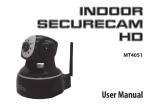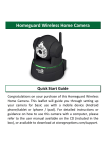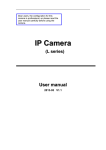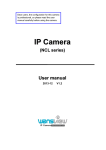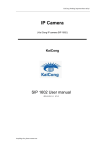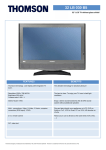Download - Media
Transcript
INDOOR SECURECAM 300K MT4050 User Manual EN Index Notice������������������������������������������������������������������������������������������������������������ 3 Product introduction������������������������������������������������������������ 3 Product summary�������������������������������������������������������������������������������������� 3 Main features���������������������������������������������������������������������������������������������� 3 Package for typical production������������������������������������������������������������ 4 Overview�������������������������������������������������������������������������������� 4 Installation guide������������������������������������������������������������������ 5 Wired connection to LAN����������������������������������������������������������������������� 5 Connecting camera to local WiFi��������������������������������������������������������� 6 Connecting camera to Internet network������������������������������������������ 7 Operation Steps:�����������������������������������������������������������������������������������������������7 Operation of IE browser�������������������������������������������������������� 8 View video��������������������������������������������������������������������������������������������������� 8 1. Audio, Talk, Record, Snapshot�����������������������������������������������������������������8 2. Multipicture change button��������������������������������������������������������������������8 3. Viewing control area�����������������������������������������������������������������������������������8 4. Setting device parameters�����������������������������������������������������������������������9 Device information����������������������������������������������������������������������������������� 9 Device status������������������������������������������������������������������������������������������������������9 Device alias setting������������������������������������������������������������������������������������������9 Device date and time setting�����������������������������������������������������������������������9 Local recording path���������������������������������������������������������������������������������������9 Device web setting����������������������������������������������������������������������������������� 9 Basic network settings�����������������������������������������������������������������������������������9 Manufacture’s DDNS setting��������������������������������������������������������������������� 10 Third party DDNS setting��������������������������������������������������������������������������� 10 UPnP settings������������������������������������������������������������������������������������������������� 10 2 Alarm Settings������������������������������������������������������������������������������������������10 Alarm service setting����������������������������������������������������������������������������������� 10 Mail Service Setting�������������������������������������������������������������������������������������� 11 FTP Service Setting��������������������������������������������������������������������������������������� 11 Alarm log���������������������������������������������������������������������������������������������������������� 12 User and device setting������������������������������������������������������������������������12 Multi-device Setting������������������������������������������������������������������������������������� 12 User Settings��������������������������������������������������������������������������������������������������� 12 PTZ settings����������������������������������������������������������������������������������������������������� 12 Maintain������������������������������������������������������������������������������������������������������������ 12 Visiting device by other software������������������������������������������������������13 Other web browser��������������������������������������������������������������������������������������� 13 Mobile phone software������������������������������������������������������������������������������� 13 Notice ■Keep away from the places for high-temperature, heat source and direct sunlight; ■Keep away from water and when get wet, cut off the power immediately. ■Avoid using at damp environment; the reference range for operation humidity is below 85%RH. ■Operation temperature is -10° ~ +50° ■Please install it horizontally or wall mounting, avoid vibration places and do not put other equipment onto the item. 1. Please check the power supply before proceeding. 2. Be careful not to bang the camera or subject it to strong impacts or shocks. 3. Do not directly touch the optical components for the image sensor, if necessary, please place a clean and moistened cloth with alcohol and wipe the dirt gently; When not in use, please place the dust cover on to the item to protect the image sensor. 4.Do not aim the camera directly into the sun or at other intense light sources that could affect the image quality (it is not the problem for the ip camera), also shorten the service life for the image sensor. 5.Keep away from laser when it is working, otherwise the image sensor can be damaged. 6. If the equipment is not working properly, please contact the store or the service center, do not disassemble or modify the equipment in any way. Unauthorized modification or repair will void warranty. Product introduction EN Product summary Thank you for choosing our securecam camera series, the IP Camera combines a high quality digital video camera with network connectivity and a powerful web server to bring clear video to your desktop from anywhere on your local network or over the Internet. It is very suitable for family, shops, office building and so on. Main features ■The video is compressed by MJPEG. You can select VGA/ QVGA/QQVGA video resolution; ■Infrared LED for night vision covers 5m area, to maintain 24 hours monitoring; ■Support WiFi 802.11b/g protocol, can build up wireless monitoring; ■Support motion detection, send alarm information by email and FTP; ■Support mobile phone to view; ■Built in web server, all data is transferred through one port; it is easy for user to do the network setting; ■Attached a label at the bottom of each IP Camera, it include DDNS address. When IP Camera is connected to the internet, this URL can be used to visit the device; ■Special software included for multi-view, long time recording, video playback etc; 3 EN Package for typical production ■ Power adaptor, ■ CD, ■ Cable, ■ Bracket L, ■ Antenna Notice: Please check carefully if all listed items are included in the package, if anything missing, please contact your vendor. Overview The camera adopts 300K pixels CMOS sensor, 3.6mm lens, built in PTZ and MIC, 8 IR LEDs, audio out socket. It uses 5V power adaptor. IR LED Lens Photoresistor Antenna Work status LED Power status LED Alarm In MIC Alarm Out Power 4 RJ45 Reset Audio Out Audio In Installation guide EN Wired connection to LAN Power on the IP camera, connect IP camera to router by network cable, meanwhile, connect computer to the same router. MT4050 Router Insert CD to computer driver, double click “LSearch_en.exe” in the CD, run the software, click “Search”, select the device searched (this process may take up to 5min), click “Browse” to open browser (you can also manually enter address, in example below it will be http://192.168.100.245). It will pop up user login dialog, enter default user name “admin” and password “123456” to login the camera. We suggest using IE browser to view the video it can provide more functions, but user needs to install video player before viewing the video. Click “OCX Download ” to download OCX and install it. If you use other internet browser you may not have access to all function of camera. 5 EN Notice: ■If you installed the firewall software in your PC, when you run the LSearch_en.exe, it may pop up a window to say “whether you want to block this program or not”, then you should choose not to block. ■You can hold on reset button on the camera for 10 seconds to restore factory default if you forget user name and password, during the process, don’t disconnect the power, otherwise the camera maybe damaged. Before connecting camera to router by WiFi, please connect via LAN as shown earlier and enter WiFi setting, and then operate as the following step. Connecting camera to local WiFi You can connect the camera to your local router by wireless connection. MT4050 Click the “Scan” button, it will show you all detected wireless networks. Select one of them and tick “Using Wireless Lan”, then the relevant data of the selected wireless network will be shown in the following blanks. Input the password and click “Submit”, then the WiFi setting is finished. Unplug the cable, camera will be connected to router by WiFi automatically. 6 Notice: When the device is connected both WiFi and wired, it will firstly connect to the wired network. If the camera enables DHCP to obtain IP address automatically, so the IP address is not same in wired connection and WiFi connection, recommend to set fixed IP address for the camera. Connecting camera to Internet network EN You should connect WiFi router to WAN (ADSL modem or other router with internet access) as shown below. If you want to access your IP camera from WAN (when you do not have access to local network), you must make a port forwarding on the router. Operation Steps: 1. After login the interface of the router, choose “Port Forwarding”; 2. Choose “Add custom Service”; 3. Input IP camera http port; 4. Input IP address of IP camera, click “Apply”. Example of forwarding port “1025” for camera with local address of “192.168.178” using “Netgear router”. After finishing the port forwarding, you can use WAN IP address to visit the camera by remote computer. Notice: because the routers are different, so the interface and setting method of router are also different, please refer to the user manual of your router or consult with router manufacturer. 7 EN Operation of IE browser View video After installing the plug-ins, click “Mode 1 to view” to view the video. Record – you can start recording video (it requires prior definition of storage in one of PC computers in local network). Snapshot - you can save snapshot (web browser will enter snapshot in new window). Call – recall previously stored camera position. Set – save actual camera position. Note: about recording path, click 4 button to enter setting interface, you can set it in “Local Recording Path”. 2 2. Multipicture change button 3 1 4 1. Audio, Talk, Record, Snapshot You can click these buttons 1 to perform audio, talk, record and snapshot functions. Audio – enable/disable capturing sound Talk – when you plug speakers to camera you can use microphone in PC computer and send your voice message online. 8 If you add multi-devices it will connect other device to display pictures automatically when changing to 4, 9 split screen. In playing video area, you can select a picture to control audio, talk, record, snapshot and PTZ control etc. 3. Viewing control area You can control PTZ moving, picture reversal and mirror etc. when viewing video, and can adjust picture parameters, includes resolution, brightness etc. The camera supports 16 preset points, you can set one place as preset point when moving the PTZ to a place, also can call the preset point when the camera move to another place, so the camera can return to set place. Note: IR button can control work mode of IR LED. IR LED may have auto, forced close two mode, the IR LED will power on or off according to environment light in auto mode; the IR LED always power off in forced close mode. 4. Setting device parameters Click 4 button to enter setting interface, you can set all parameters of the camera described later in this in manual. Only administrator can login to set these parameters. Remark: Please carefully check the camera time, so it can be sure the alarm accuracy. Local recording path The camera will be automatically create a file folder named “Record files” when the user don’t set “local recording path” and launch recording directly, and then save recording file to the folder. Device information Device status The user can obtain “Device firmware version”,” Web UI version”, “Alias”, “AP MAC” etc. Device alias setting The user can name the camera, example for home, office etc. Device date and time setting You can enable “Sync with NTP Server” when the device was connected to WAN, but need to select correct time zone where the camera is located, otherwise need to select“ Sync with PC time”. Device web setting Basic network settings The user can also enter the Basic Network Settings to set the IP address except using the search software “LSearch_ en.exe”. 9 EN EN Remark: The router connected to camera need to enable DHCP when the user uses “obtain IP from DHCP server”; the routers enable DHCP by default. Manufacture’s DDNS setting Manufacturer puts a label of DDNS at the bottom of each IP Camera, it is unique, the manufacturer has established a DDNS system, and allotted a DDNS to every device, the user only enter the website into browser, and then view it from remote PC. Third party DDNS setting User can also use third party DDNS, such as www.dyndns. com, User must apply a free domain name from this website and fill the info into the below blanks and save the settings. Then the domain name can be used. UPnP settings If you enable UPnP, once the IP camera is connected into the LAN, it will communicate with the router in the LAN and do the port-forwarding with open port of router automatically. You only tick “Using UPnP to Port Mapping” to finish the setting. Before using the UPnP function, please make sure the router’s UPnP function has been enabled. Not all the routers support UPnP perfectly. Please test if the router works well with the equipment, if not, we suggest you to disable this function and do the port-forwarding manually. Alarm Settings Alarm service setting If user need to monitor a fixed area, when there is any motion, it will detect the motion and trigger the alarm. In the motion detect sensibility, the smaller the value, the more sensitivity. Notice: Using the third party domain name, if the http port is not 80, the port number should be adding to the domain name with colon. Example: http://btest.dyndns.biz:81. Don’t enter port number when you use manufacturer’s DDNS. 10 After triggering the alarm, you can adopt several alarm mode in armed time. ■Link to the Preset when alarming: need to set preset point of the camera; ■Send alarm info by email (a email include a picture); every alarm trigger a email; ■Send the snap to the FTP server, user can also set the interval time between two pictures. EN Device only triggers alarm when it detects any motion in armed time. User can set schedule time to be “all the time”, also assign the armed time. Before you set “Time Schedule”, please go to Date and Time settings to set the correct time for the item. FTP Service Setting When alarming, the device will snap local picture and send them to FTP server, but need to set the FTP setting correctly. After the setting is finished, click “Test” to check your settings are correct or not. Mail Service Setting When it detects alarming, it can send email to your appointed email box, but you need to set email service parameters correctly. Click “Submit” to save these parameters, and then you can click “Test” to check if the setting is successful. Notice: For using the FTP function, you need to apply a user with authority that you can write and create submenu and some memory space. 11 EN Alarm log You can inquire when the device performs alarm in alarm log. User Settings PTZ settings User and device setting Multi-device Setting User can add maximum 9 devices to view video simultaneously. Click “refresh” button to check the device in the LAN. When click a device, will popup setting dialogue and enter the device info, and click “Add” to add device. After that, must click “Setup” button to save device. Note: When you set cruise turns all the time, the camera will automatically stop after cruising one hour. Maintain Click “Restore factory settings”, it will pop up a dialog to ask you if restore factory settings, the camera will restore factory settings and reboot after you confirmed. There are two types software in the camera, one is device firmware, another is Web UI, and you can upgrade them respectively. 12 Visiting device by other software EN Other web browser Except IE browser, you can visit the camera by Firefox, Safari, Chrome, Opera browser etc., please select “Mode 2 to view”. Mobile phone software For more information, please see the user manual for mobile phone in attached CD, or download the latest software (you can find it at Google Play “iSmartViewPro”). Due to continuous development specification and appearance of product are subject to change without prior notice. For technical support please visit www.media-tech.eu. 13













